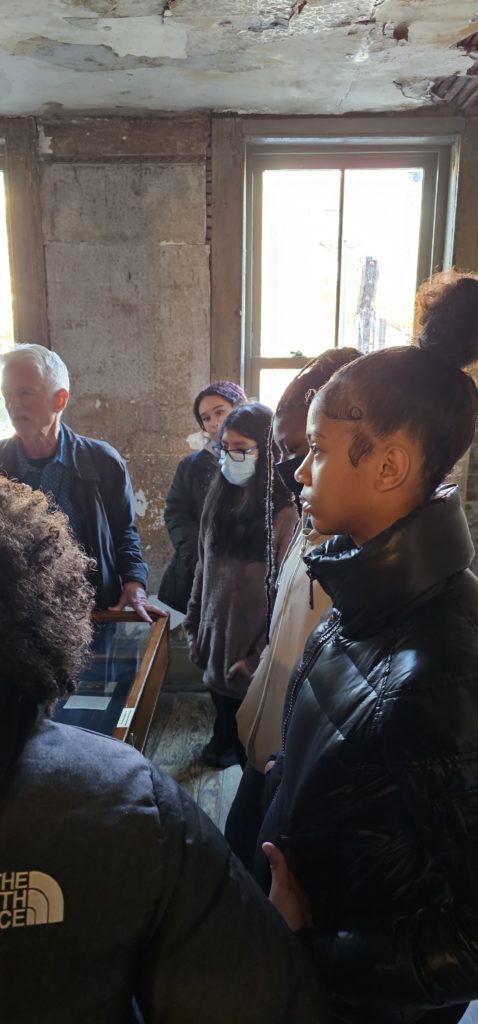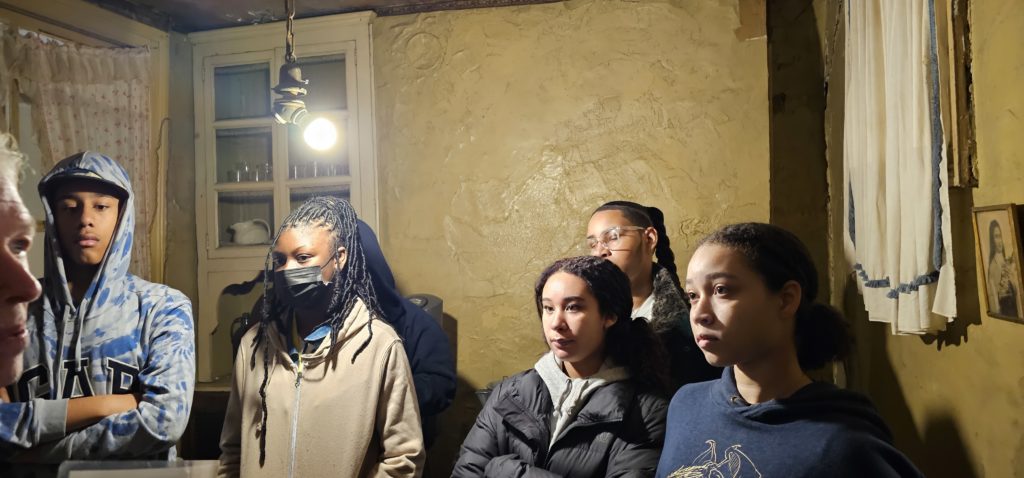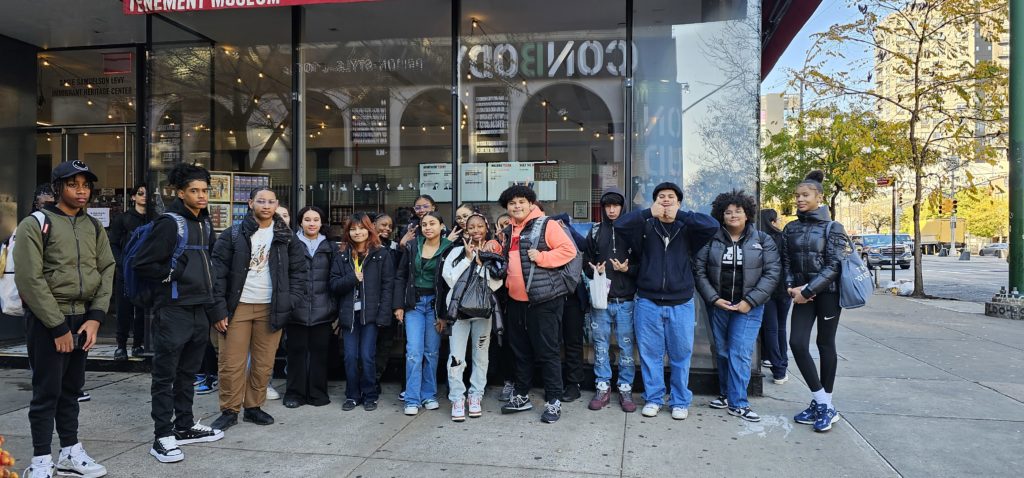Freshman, Alison Sanchez, wrote the introduction to this story.
On November 16th, a select group of 9th grade students were chosen to participate on a trip to the Tenement museum as a part of their ELA unit’s essential question- “What does it it means to be ‘American?’” Students were also encouraged to gather insight on the lives of immigrant families which opened a window to the American story.
The tenement museum is located on 103 Orchard Street in the Lower East Side neighborhood of Manhattan. This museum allows visitors to explore the historically recreated homes of immigrant, migrant, and refugee families who lived in the city tenements between the years of 1863 and 1935.
The tenements were once home to an estimated 7,000 people, all of different backgrounds. On the trip we learned about a German and Russian immigrant family.
The following are student accounts of their experience at the museum.
-Marjorie Santana
Yesterday we learned about three different immigrant families living in the same building during different periods of hard times in America. I recall how the living conditions were described and the occupations of these types of apartments in New York City. Conditions for living weren’t great, and you would most likely be sharing a room with other families. One family was Jewish while one was Italian, and I can’t recall the last one, but two of these families had become close enough friends to have their babies be godchildren of people from the other family for many generations going on after they met. One family had lived through the 1920s and 1930s in this apartment building during the Great Depression. The Italian family had to go through a lot to immigrate: the wife had been arranged to marry the husband and had to sneak her way into America. They had two children, I believe, and the husband lost his job due to the Great Depression. We learned about these people’s lives and the stories told by what was left behind in the tenement museum. I found it interesting that they actually found relatives of the people who lived there or the children who once lived there as well. The Tenement Museum was a great trip and our tour guide through the museum had explained these families’ stories very well.
-Mariella Espino
The tenement museum was very interesting and very important to me. I learned so much about how people lived, how they maneuvered around the tenement, and how they dealt with harsh conditions. The different families who lived in these small compartments and how such a small place brought many connections later and even now in life. How each family grew up with each other and how long they stood in these tenements before they shut down was all very interesting information.
-Emmanuel Veras

During my trip to the Tenement Museum, I learned that there was more than one family living in each tenement, and there were bathrooms in the hallways that those families shared. We also learned about the girls who worked in factories, and in those factories, you’d have to pay for a seat, otherwise you had to spend the day standing. The boss in that factory would pay the workers very little for the large amount of work they were doing. The seats the workers paid for were very close together, and they had to stay there for a large amount of time, so if one person got sick, it would pass over to the next person, and so on. One day, the factory caught on fire, but their boss made them stay inside to keep working, and the factory was a tall building so when the fire fighters got there, their ladder wasn’t tall enough for the building, so they weren’t able to help everyone. As a result, most of the workers in the factory died from the fire. We also heard a recording from one of the family members who lived in the tenement, and she described her life living there. We looked at pictures of the families who lived in the tenement, and we learned about their lifestyles.
-Saphire Celestine
During our trip to the Tenement Museum we were presented many things, one which included the old architecture of the home that was once occupied by immigrants. While many things were preserved in the apartment, there was still visible damage done to areas of the house to show how time had taken a toll. An example of this is the paintings on the walls which had been covered by dust and grime completely covering the painting. Once we moved up into further floors in the apartment one could see how the walls had also been affected, which also led to one of the first rooms we visited.
The rooms we visited belonged to immigrants both similar and yet drastically different. Families were from different religions carrying different very beliefs, yet they lived in the same apartments at the same time living through the same experiences. Many members within families worked in factories because this was a period of the Industrial Revolution. We also learned how both families often times helped each other out, such as when one of the families was not able to touch electricity on shabbat and so the family often called over the youngest daughter of the family living across from them to assist them when they needed anything, which was also a great honor to the girl who enjoyed helping them.
-Alison Sanchez
One thing I learned is that there were a lot of families living in one home. It was a big home but so were the families. A family of eight lived in one room. There were 3 rooms: the kitchen, bedroom, and living room, and all served as a bedroom. In the kitchen there was a bed not far from the stove which was in fact used for everything. Two sisters, both teens, slept in the bed. It doesn’t sound bad, but the bed was small, smaller than an average twin bed. In the living room, there was a sofa. It was thin and four children slept on that one sofa. The children were required to pull up chairs and lay their feet up. They would all sit on the couch normally, and their legs would stretch out onto the chairs they pulled up and for the night they had slept sitting up. For the bathroom part, there was one bathroom on the floor shared by all tenants sleeping on that floor. There were several families on one floor so there were like 20-50 people sharing one bathroom.
-Laniya Baringer
The trip to the museum was really fun, which I did not expect. I really enjoyed knowing how the families lived and how the time has changed and how home technology changed, how job opportunities changed, how clothes changed, food, hair products and more. Being in that ‘home’ I know back then it wasn’t easy, peaceful or comforting because of how many families had to fit in such a small apartment. I learned and heard the voice of one of the daughters of a family talking about how it was to live in the apartment with such a “big” family. She also talked about how hard it was to live because they were immigrants, how she had to work for hours, and she didn’t get paid very well.
One of the daughter’s, Josephine, from the family talked about how it was hard for her mom because she left her family in Italy and she couldn’t go back. Music reminded her of her home, and she would start to cry. She didn’t see her family for many years. Something that I loved about the trip was obviously seeing how they lived and learning about their experiences but it was also how the second the Baldizzi, who were Russian, helped each other and came together as a family and how the daughters of both families worked to help their parents. Both stories from both families were entertaining and I really liked learning about them.
-Lisbeth Rosario

During this experience I’ve learned how much of a struggle immigrant families went through to live and survive in a country like America. We went to the Tenement Museum and learned about two immigrant families who went out of their way to come to this community to escape from the ones who were beginning to persecute them. The two specific families were the Italian-Christian family, the Baldizzis, and the Russian-Jewish family, the Rogarshevsky’s. They were both different families but shared a beautiful intimate relationship between four walls. The Baldizzis’s were leaving Italy after the mother and father officially got married because he wanted to make more money for his expertise. Eventually, two years later his wife came and brought their kids. The Rogarshevsky’s were a Russian- Jewish family who arrived in America in 1901, expecting to escape because Russia was persecuting people. They took the father’s brother’s last name to enter the United States. When they got there, they immediately had to work, especially the eldest children. Unfortunately, during the Great Depression it was hard to stay stable for both families and eventually the building closed down in 1935 with 7 out of 21 families still maintaining a life there. Since the landlord refused to repair the building, the city shut down the building, and these poor immigrant families had to survive elsewhere. But they pulled through together.
-Alanis Garcia
During the tour in the Tenement Museum, I learned about families like the Rogarshevskys and the Baldizzis who struggled living in tiny apartments. These families were immigrants that came to New York; they were not looking for handouts. Their objective was to go out to work to keep their families on their feet. When the Rogarshevky’s arrived in New York, they found out that they had to work on their resting day, the day that they would go to church. Instead of working on their resting day, they found out that they could sell things out of their push carts to gain money. While teenagers had to go to school for about 4 hours, they still had to work in places like factories to help their family. This may be a relief to them because they were able to have freedom, instead of being watched under their parents in a three room apartment. In the apartment that we were shown, about 21 families lived there. Most of the families moved out of the apartment to live under better conditions, leaving 7 families in the building. Later the families were told to move out, leaving the apartment vacant because the landlord did not want to get the work needed to maintain the apartment.
-Maiya Parish
For more information on the stories of the families mentioned, please visit the following links:

